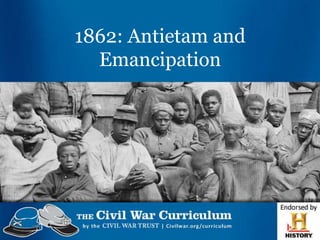
Antietam and emancipation high school nlo.ppt
- 2. The War So Far
- 3. The War So Far The Confederacy was hoping that Great Britain and France might help them in the war, giving the Confederacy an advantage.
- 4. The War So Far What is the war about? Preserving the Union or Freeing the Slaves?
- 5. The War So Far Reasons a Victory was Needed: – Lincoln wanted to show that his government was strong and could support or “back up” the proclamation. – Lincoln didn’t want it to appear that his government was weak, and that he was asking the slaves to rebel against their masters.
- 7. Antietam Activity As a group read the Battle of Antietam Summary.
- 8. Antietam
- 9. Emancipation
- 10. Emancipation
- 11. Emancipation
- 12. Emancipation His first challenge was that the U.S. Constitution did not prohibit slavery. Individual states could outlaw slavery, but not the U.S. Government.
- 13. Emancipation Lincoln used his background as a lawyer to come up with a solution more or less based on the following questions that I would like you to answer:
- 14. Emancipation Question: How did slave owners legally consider their slaves (and horses, buildings, etc…)?
- 15. Emancipation Answer: Slaves were considered to be property.
- 16. Emancipation Question: What happens to property that armies capture from their enemy during a war? Image courtesy Library of Congress
- 17. Emancipation Answer: The property captured (called contraband) belongs to the army that captured it and its government.
- 19. Emancipation Activity Look at your excerpt from the Emancipation Proclamation. Let’s read the second paragraph together. Image courtesy Library of Congress
- 20. Emancipation The war was no longer just about preserving the union, it was also about freeing the slaves.
- 21. Emancipation
- 22. United States Colored Troops
- 23. United States Colored Troops In the Emancipation Proclamation Lincoln addressed the enlistment of African Americans in the United States armed forces. Activity In paragraph #8 Lincoln discusses them being accepted into the military. Let’s read it together. Image courtesy Library of Congress
- 25. United States Colored Troops Activity Let’s read an excerpts from General Order 143, which created the “United States Colored Troops” (USCT). Image courtesy National Archives
- 26. United States Colored Troops Question: What do you think were some advantages for the United States in having African Americans serve in the military?
- 27. United States Colored Troops Answer: African Americans joined the United States military in large numbers. Which led to a larger army, one of the deciding factors in the United States defeating the Confederacy.
- 29. Key items to remember from today’s lesson • The “bloodiest” day in American history was the Battle of Antietam, Maryland. • The Union “victory” at Antietam allowed President Lincoln to issue the Emancipation Proclamation. • Great Britain and France remained neutral and did not enter the war on the side of the Confederacy. • The Emancipation Proclamation freed slaves in the Confederate States (Eventually all states would free their slaves) • With African Americans joining the armed forces, the United States had a greater advantage over the Confederate States because of its number of soldiers and sailors.
Notes de l'éditeur
- The war had not been going well for the Union armies around Washington, D.C.The Union had lost every major battle in which it had fought in 1861 and 1862.
- The stated purpose of the war by the United States was to save the Union. However, abolitionists and Republicans were pressuring Lincoln to making freeing the slaves a goal of the war.
- Before freeing the slaves could be added to the war aims Lincoln felt strongly that the Union needed a victory.
- The result of the Battle of Antietam (or Sharpsburg, as the Confederates called it), the Confederate army left Maryland and went back into Virginia, allowing the Union to claim a victory.
- Abraham Lincoln now had a victory to issue the Emancipation Proclamation.
- However, Lincoln had some challenges to overcome before he wrote the Emancipation Proclamation.
- Lincoln therefore stated in his Emancipation Proclamation that any property (slaves) captured by U.S. military forces would be freed.
- The Union demonstrated its ability to fight and win against the Confederate army. In addition, most Europeans did not like slavery. Therefore, now that the war was about freeing the slaves, they decided not to get involved with either the Union or the Confederacy.
- Lincoln had some other challenges. He wanted African American men interested in joining the United States military to be able to do so.However, some white, Union soldiers did not want to serve with African American soldiers. There were also concerns about how well African Americans would fight since most of them did not have any military service.
- The War Department decided that African American soldiers would be placed in all African American units commanded by white officers.
- African Americans were now directly involved in their own emancipation.